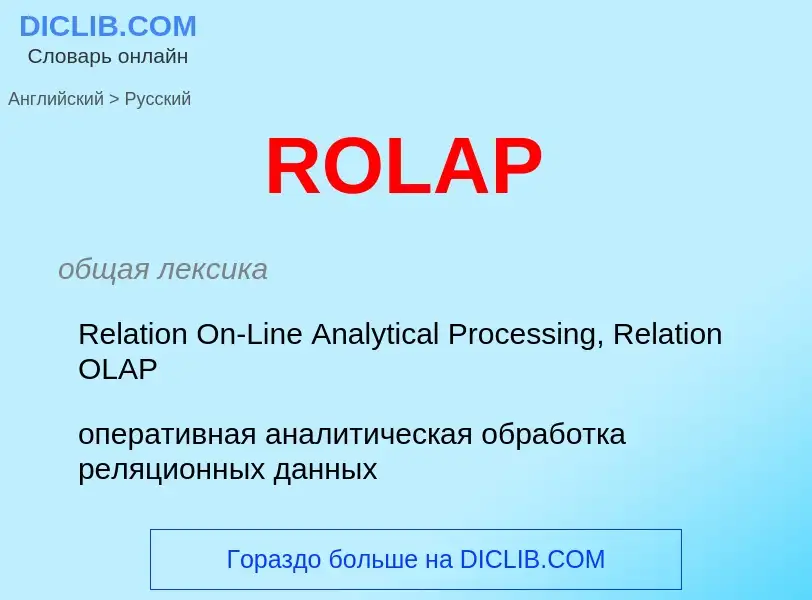Traduzione e analisi delle parole tramite l'intelligenza artificiale ChatGPT
In questa pagina puoi ottenere un'analisi dettagliata di una parola o frase, prodotta utilizzando la migliore tecnologia di intelligenza artificiale fino ad oggi:
- come viene usata la parola
- frequenza di utilizzo
- è usato più spesso nel discorso orale o scritto
- opzioni di traduzione delle parole
- esempi di utilizzo (varie frasi con traduzione)
- etimologia
ROLAP - traduzione in russo
общая лексика
Relation On-Line Analytical Processing, Relation OLAP
оперативная аналитическая обработка реляционных данных
в СУБД - технология представления многомерных данных на базе реляционной СУБД. При этом обычно используется звёздообразная схема, которая состоит из таблицы "Факт" и множества поддерживающих её таблиц "Измерение"
Смотрите также
общая лексика
Hybrid OLAP
гибридный OLAP
один из видов систем оперативного анализа данных (см. OLAP), в котором исходные данные размещаются а реляционной БД, а агрегатные - хранятся в многомерной БД
Смотрите также
общая лексика
Online Analytical Processing
оперативный анализ данных, онлайновая аналитическая обработка [данных]
оперативный анализ данных для поддержки принятия важных решений. Исходные данные для анализа представлены в виде многомерного куба, по которому можно получать нужные разрезы - отчёты. Выполнение операций над данными осуществляется OLAP-машиной. По способу хранения данных различают MOLAP, ROLAP и HOLAP. По месту размещения OLAP-машины различаются OLAP-клиенты и OLAP-серверы. OLAP-клиент производит построение многомерного куба и вычисления на клиентском ПК, а OLAP-сервер получает запрос, вычисляет и хранит агрегатные данные на сервере, выдавая только результаты. Термин OLAP был предложен Е. Коддом (E.F. Codd) в 1993 г. вместе с 12 правилами
Definizione
Wikipedia
Online analytical processing, or OLAP (), is an approach to answer multi-dimensional analytical (MDA) queries swiftly in computing. OLAP is part of the broader category of business intelligence, which also encompasses relational databases, report writing and data mining. Typical applications of OLAP include business reporting for sales, marketing, management reporting, business process management (BPM), budgeting and forecasting, financial reporting and similar areas, with new applications emerging, such as agriculture.
The term OLAP was created as a slight modification of the traditional database term online transaction processing (OLTP).
OLAP tools enable users to analyze multidimensional data interactively from multiple perspectives. OLAP consists of three basic analytical operations: consolidation (roll-up), drill-down, and slicing and dicing.: 402–403 Consolidation involves the aggregation of data that can be accumulated and computed in one or more dimensions. For example, all sales offices are rolled up to the sales department or sales division to anticipate sales trends. By contrast, the drill-down is a technique that allows users to navigate through the details. For instance, users can view the sales by individual products that make up a region's sales. Slicing and dicing is a feature whereby users can take out (slicing) a specific set of data of the OLAP cube and view (dicing) the slices from different viewpoints. These viewpoints are sometimes called dimensions (such as looking at the same sales by salesperson, or by date, or by customer, or by product, or by region, etc.).
Databases configured for OLAP use a multidimensional data model, allowing for complex analytical and ad hoc queries with a rapid execution time. They borrow aspects of navigational databases, hierarchical databases and relational databases.
OLAP is typically contrasted to OLTP (online transaction processing), which is generally characterized by much less complex queries, in a larger volume, to process transactions rather than for the purpose of business intelligence or reporting. Whereas OLAP systems are mostly optimized for read, OLTP has to process all kinds of queries (read, insert, update and delete).

